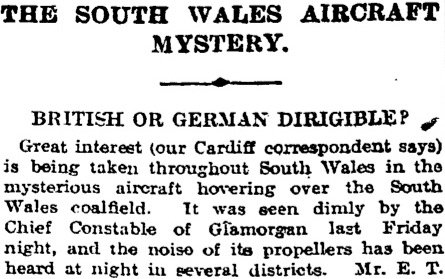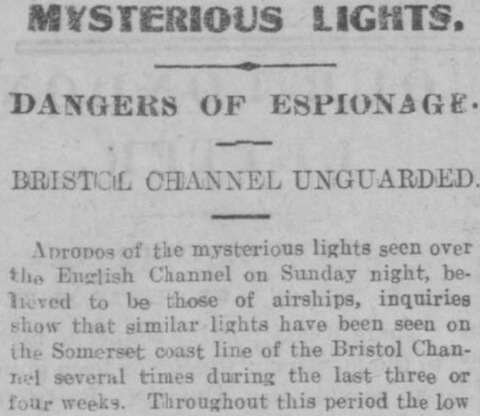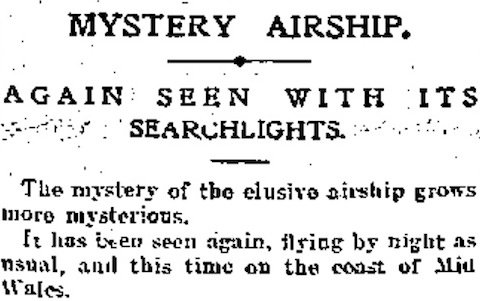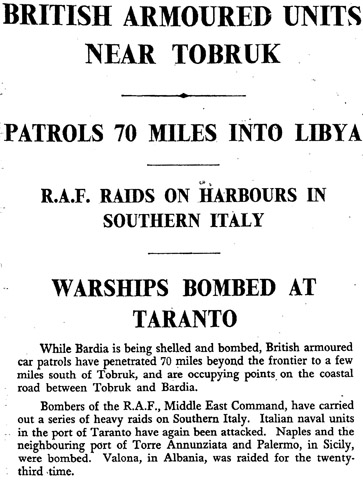
Not a lot of new scareship news today. The Cardiff airship seen last Friday remains the principal focus. The Dundee Evening News reprints, p. 5, the same article about further witnesses carried by a number of newspapers yesterday, so that’s nothing new. The Manchester Guardian says, p. 12 (above) that ‘the noise of its propellers has been heard at night in several districts’, which is new, but no details are provided.
Of greater interest are the interviews which ‘Mr. E. T. Willows, the well-known Cardiff airman’ has been giving to the press, or at least to representatives of the Guardian and the Standard, suggesting that ‘the “long, oval shape” referred to by one or two observers suggests that it may have been a dirigible balloon’. The way in which these interviews are framed is quite revealing. The Guardian is a Radical paper and so congenitally predisposed to scepticism about talk of spies and invasions. As well, it is broadly in political sympathy with the Liberal government now in power and therefore disinclined to support any charge that it is failing in its duty to defend the nation. Conversely the Standard is robustly Conservative in its views and regularly runs articles about this or that foreign menace (a word which the Guardian is apt to put in scare quotes). Just today it has the fourth in a series of articles on ‘The Navy and the nation’ attacking Churchill’s naval policy, along with a supporting leading article.
Unsurprisingly, then, the Standard portrays Willows as coming down on the side of a German origin for the mystery airships, p. 9:
Mr. E. T. Willows […] expressed the opinion that the aircraft was one of the German vessels of the Schuttelanz [sic] or Zeppelin type. ‘English people,’ he said, ‘are not aware of the great power possessed by this aircraft, of which the Germans possess seven or eight. They are very finely constructed vessels, which can travel 40 to 50 miles an hour under favourable conditions, and which can keep in the air for 35 hours or more. The Germans keep some of these ships at their new naval base at Cookshaven [sic] and other points on the north-western portion of the German seaboard. They can cover from 1800 to 2000 miles in a flight, and the South Wales coalfield comes within the possible area of their operations.’
So this fits in gratifyingly well with the Standard‘s previous analysis of German aerial capabilities. But according to the Guardian, p. 12, Willows said something slightly different. Yes, he said the same things about speeds and ranges and in fact made some even more dramatic statements (‘the South Wales coalfield [is] well within range of the destroying powers of these German aircraft […] we have nothing in this country at present in any way to equal this type of aircraft’). But his actual opinion as to the identity of the mystery airship?
‘It is possible,’ Mr. Willows continued in reply to a question, ‘for some of the German airships of the Zeppelin-Schutte-Lang [sic] types to make a trip as far as South Wales.
So the Guardian quotes him as saying it is ‘possible’ that the scareships are German, and the Standard paraphrases him as being of the ‘opinion’ that they were. Hmmm. Moreover the Standard omits to quote, or omitted to ask, Willows’s views on whether a British airship could be responsible. The Guardian did not:
‘The two big airships of the British War Office, the Gamma and the Delta, are capable of a journey all over South Wales. The Gamma has a speed of about thirty miles an hour, and she is now in the new envelope which I made for her last year to enable her to take long trips. The Delta is also capable of taking long trips, but at the present time she is out of commission, undergoing alterations. The smaller airship, the one which I made for the navy authorities, is at present being used at Farnborough for training the officers and men of the naval wing of the Royal Flying Corps.’
Later, after pointing out that Britain had nothing to equal the Zeppelins (‘and the only attempt made so far has been the one at Barrow‘), Willows enigmatically says ‘I personally have been working upon plans of a similar nature which in the near future may materialise, but upon these points I must not say more at present’. The Guardian doesn’t come to a conclusion, but such statements under the headline ‘British or German dirigible?’ and followed by a report that the Gamma had flown over London suggest that there is room to believe in a native and less alarming origin for the phantom airships. Neither the Guardian nor the Standard, however, point out, that Willows, as a supplier of airships to His Majesty’s Government himself, might not be completely disinterested in this matter.
There is a glimpse of the state of public opinion regarding the scareship mystery. The Guardian says that ‘Great interest […] is being taken throughout South Wales in the mysterious aircraft hovering over the South Wales coalfield’. The Exeter Western Times is rather more interesting, p. 4:
although many people doubt that the Chief Constable [Lionel Lindsay] saw anything out of the common [at Cardiff], others are inclined to connect the incident with the appearance of other mysterious aircraft and lights in the neighbourhood of the Bristol Channel […] Opinion is crystallising in the belief that there is in existence a whole fleet of airships [near Bristol], and that the locality is being used for manœuvring purposes.
A whole fleet of airships! That would be something. The Western Times, though, thinks it ‘more probable’ that only ‘one aircraft’ is visiting the Bristol area, at night ‘to avoid unnecessary publicity’, and it’s just that multiple people seeing the same object give rise to the impression of multiple objects. ‘Officials of the Bristol and Colonial Aeroplane Company disclaim any knowledge of the nightly visitor.’
On the Bristol lights, the Western Times notes ‘a swiftly moving bright light seen in the sky, rising and falling, and finally disappearing in the direction of the Bristol Channel’; no date is given. A meteor is ruled out because ‘it rose and fell as it progressed’:
One eye witness states that a bright light suddenly appeared in the sky approaching Bristol from the south-west, and turning northward when in the vicinity of Horfield, and ultimately going back in the direction of the Channel.
The Western Times has a long memory:
The incidents recall the mysterious appearance in North Devon and in the vicinity of Exeter some four years ago of weird lights late at night, accompanied by the whirr of machinery. At Ilfracombe, in Exeter, and other parts, people testified to the presence of an unknown airship moving at an enormous rate in the darkness. Policemen spoke of seeing it, and their stories were backed up by prominent civilians, but still there was a feeling scepticism [sic] generally, and hundreds who kept a weary and fruitless vigil in the hope of solving the mystery remained unconvinced that anything unusual had happened.
The suggestion that large crowds of people, at least in Devon, kept watch for phantom airships in 1909 is interesting, as is the one that they didn’t see what they were looking for.
![]() This work is licensed under a Creative Commons Attribution-NonCommercial-NoDerivatives 4.0 International License.
Permissions beyond the scope of this license may be available at http://airminded.org/copyright/.
This work is licensed under a Creative Commons Attribution-NonCommercial-NoDerivatives 4.0 International License.
Permissions beyond the scope of this license may be available at http://airminded.org/copyright/.




Pingback: Friday, 24 January 1913
Pingback: Monday, 10 February 1913
Pingback: Saturday, 8 March 1913 | Airminded